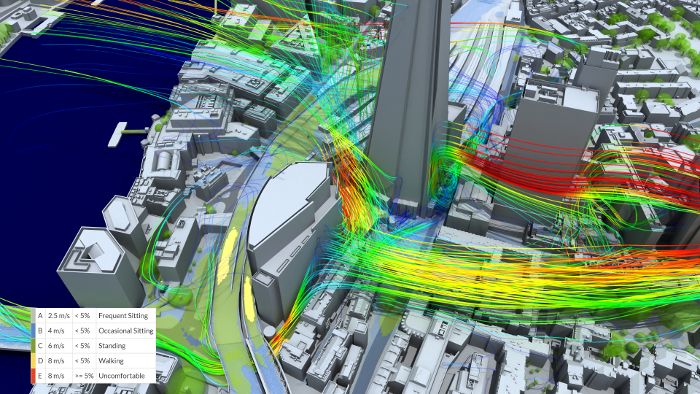The cloud-based simulation platform is designed to accelerate pedestrian wind comfort studies
SimScale has updated its cloud-based simulation platform to help engineers and architects planning new developments in London to quickly asses pedestrian wind comfort and safety and comply with the city’s microclimate guidelines.
Published in August 2019, the Wind Microclimate Guidelines for Developments in the City of London describe the required studies to assess a planned structure’s impact on the comfort and safety of nearby pedestrians and cyclists. Within the guidelines, computational fluid dynamics (CFD) is among the recommended approaches for buildings 25 meters or higher and is a requirement for buildings 50 meters or higher. Further, the guidelines encourage developers to address wind impact early in the design process and require that multiple scenarios are studied.
Urban designers, architects, and engineers using SimScale can now directly use the exact wind statistics data as defined in the guidelines, run wind analyses for 36 wind directions, and assess pedestrian wind comfort and safety according to the London LDDC criteria on an annual, seasonal, and also worst-case scenario. It’s also possible to analyse the transient wind flow patterns around the buildings using streamlines, velocity vectors and much more for each of the 36 wind directions.
“SimScale’s workflow makes it possible for engineers to comply with the CFD requirements of the Wind Microclimate Guidelines for developments in the City of London quickly and easily,” said Richard Szöke-Schuller, product manager at SimScale. “Developers are guided by SimScale’s workflow to enter parameters and perform needed calculations. Because SimScale is cloud-based, multiple simulation scenarios can be run in parallel. All of this not only saves time, but allows for design validation to happen early and iteratively.”
Meanwhile, SimScale has added enhanced collaboration features and a multi-user licensing package to its cloud-based simulation software to support design, engineering, and architecture teams that may span various locations and time zones.
SimScale’s Team Plan allows teams to always share and work on a “single source of truth” —live and interactive. According to SimScale, this is in contrast to traditional CAE desktop applications where virtual testing is done sequentially and in silos, which can lead to long design iteration times.
If you enjoyed this article, subscribe to our email newsletter or print / PDF magazine for FREE






